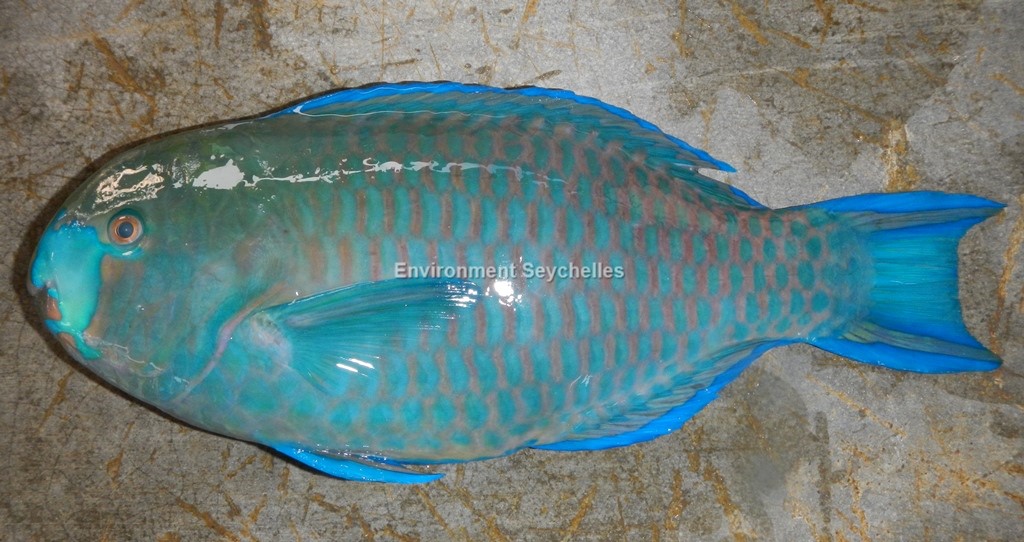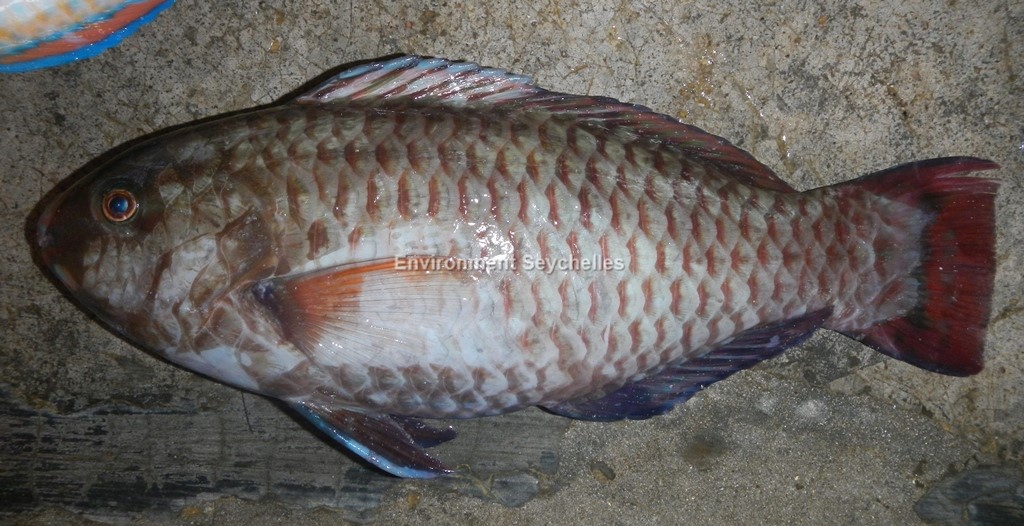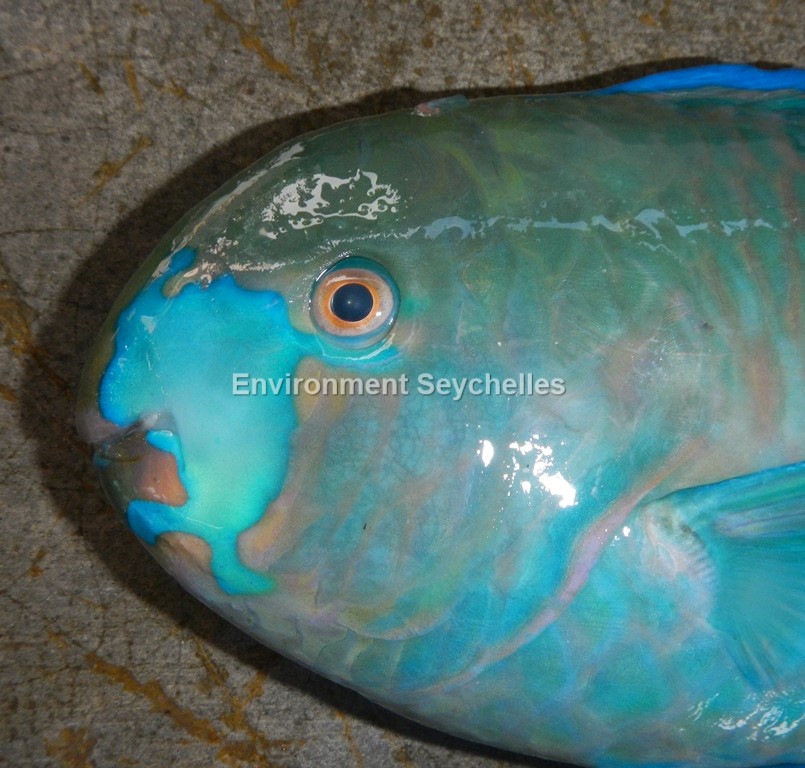Description:
Dorsal Spines: 9; Dorsal rays: 10; Anal spines: 3; Anal rays: 9.
Relatively small, full-bodied parrotfish. Cheek scale rows 3. Lips cover three-fourths to all of dental plates. Initial phase with 0-1 canine teeth
posteriorly on side of upper dental plate and 0-2 on lower; canine teeth better developed on terminal males, 1 or 2 in both jaws. Dental plates white.
Caudal fin truncate in Initial phase and emarginate in Terminal phase.
Initial phase: dark brown, sometimes with 5 faint irregular pale bars, of 1 or 2 vertical scale rows, on body. Head dark reddish to orangish brown, the
red more prominent anteriorly. Iris reddish to orangish. Fins dark reddish to orangish brown, the pectoral membranes pale.
Terminal phase: body green, the scales with pink bar. Head dull green, shading to orangish ventrally, with a large area of brilliant blue-green on side
of snout and anterior cheek in front of orbit that runs under the chin. Front of snout and medial portion of upper lip, chin and most of lower lip
salmon-pink. Iris orange. Dorsal and anal fins green basally with orange stripe above and blue margin. Pectoral fin membranes pale, the rays blue-green
except for a streak of dull orange on fourth to sixth rays. Pelvic fins blue with a streak of orange. Caudal fin blue green, blue lobes with longitudinal
orange-pink bands.
Size:
Maturity: Lm unknown. Range unknown. Max Length: 45 cm TL.
Specimens in Seychelles typically much smaller than the above cited global maximum. A 2019-20 study of the parrotfish fishery recorded largest specimen of
27.5 cm TL (Nevill 2020).
Habitat and Ecology:
Found solitary in shallow water reefs, reef flats, fronts and rocky shores (depth 1-15 m). Feeds on benthic algae. Oviparous, distinct pairing during breeding.
Fishery Status:
This species is not protected or subject to fishery regulations. It is caught in the fish trap fishery, where it is an occasional and generally scarce
component of the catch.
Notes:
References:
Allen, G. (2012). Scarus viridifucatus. The IUCN Red List 2012: http://dx.doi.org/10.2305/IUCN.UK.2012.RLTS.T154971A17900949.en. (01/04/19).
Bray, D.J. (2018). Scarus viridifucatus in Fishes of Australia, http://fishesofaustralia.net.au/home/species/5019 (01/04/19).
Froese, R. & D. Pauly. (Eds.) (2019). FishBase. https://www.fishbase.se/summary/7914 (01/04/19).
Nevill, J.E.G. (2020). Assessment and Valuation of the Parrotfish Fishery to Support an Ecosystem Approach to Fisheries. Project Report.
Randall, J.E. & Bruce, R.W. (1983). The Parrotfishes of the Subfamily Scarinae of the Western Indian Ocean with Descriptions of Three New species.
Ichthyological Bulletin of the J.L.B. Smith Institute of Ichthyology. Number 47 March1983 ISSN: 0073-4381
Citation:
Nevill, J.E.G. (2019). Scarus viridifucatus, Roundhead parrotfish. Seychelles Seatizens. www.seatizens.sc. https://seatizens.sc/species/scarus-viridifucatus-smith-1956/ (updated 23/08/22).




pin up apk yukle https://azerbaijancuisine.com/# pin-up online casino
pin-up 306
https://northern-doctors.org/# mexican pharmacy
best online pharmacies in mexico mexican northern doctors purple pharmacy mexico price list
buying from online mexican pharmacy: Mexico pharmacy that ship to usa – pharmacies in mexico that ship to usa
purple pharmacy mexico price list: northern doctors – mexican rx online
purple pharmacy mexico price list mexican pharmacy reputable mexican pharmacies online
https://northern-doctors.org/# mexican online pharmacies prescription drugs
mexican rx online: mexican pharmacy – purple pharmacy mexico price list
buying prescription drugs in mexico online: mexican pharmacy northern doctors – п»їbest mexican online pharmacies
https://northern-doctors.org/# medication from mexico pharmacy
best online pharmacies in mexico: mexican pharmacy northern doctors – best online pharmacies in mexico
mexico pharmacies prescription drugs mexican pharmacy online buying from online mexican pharmacy
https://northern-doctors.org/# mexico drug stores pharmacies
best online pharmacies in mexico: mexican pharmacy northern doctors – mexican online pharmacies prescription drugs
buying prescription drugs in mexico: mexican pharmacy online – mexican online pharmacies prescription drugs
http://northern-doctors.org/# mexican mail order pharmacies
medication from mexico pharmacy: Mexico pharmacy that ship to usa – medication from mexico pharmacy
https://northern-doctors.org/# medication from mexico pharmacy
buying prescription drugs in mexico: mexican northern doctors – mexican drugstore online
mexico pharmacies prescription drugs: northern doctors – mexican rx online
reputable mexican pharmacies online mexican northern doctors purple pharmacy mexico price list
https://northern-doctors.org/# pharmacies in mexico that ship to usa
mexico drug stores pharmacies: northern doctors – mexican mail order pharmacies
https://northern-doctors.org/# п»їbest mexican online pharmacies
mexican pharmacy: mexican pharmacy northern doctors – mexican border pharmacies shipping to usa
mexican online pharmacies prescription drugs northern doctors medication from mexico pharmacy
https://northern-doctors.org/# mexican online pharmacies prescription drugs
http://northern-doctors.org/# mexico drug stores pharmacies
https://northern-doctors.org/# mexico drug stores pharmacies
buying from online mexican pharmacy mexican pharmacy northern doctors mexican pharmaceuticals online
https://northern-doctors.org/# mexico drug stores pharmacies
http://northern-doctors.org/# mexican border pharmacies shipping to usa
https://northern-doctors.org/# medication from mexico pharmacy
https://northern-doctors.org/# mexico pharmacies prescription drugs
purple pharmacy mexico price list mexican pharmacy northern doctors medicine in mexico pharmacies
https://northern-doctors.org/# reputable mexican pharmacies online
http://northern-doctors.org/# п»їbest mexican online pharmacies
https://northern-doctors.org/# mexico drug stores pharmacies
mexican drugstore online mexican pharmacy mexican online pharmacies prescription drugs
https://northern-doctors.org/# medicine in mexico pharmacies
http://northern-doctors.org/# pharmacies in mexico that ship to usa
https://northern-doctors.org/# purple pharmacy mexico price list
mexican rx online cmq mexican pharmacy online buying from online mexican pharmacy
https://cmqpharma.com/# mexican border pharmacies shipping to usa
buying prescription drugs in mexico online
mexican pharmacy mexico pharmacy mexico drug stores pharmacies
indian pharmacy online: indian pharmacy – п»їlegitimate online pharmacies india
https://indiapharmast.com/# indian pharmacies safe
mexico drug stores pharmacies: medicine in mexico pharmacies – pharmacies in mexico that ship to usa
canadian pharmacy meds review canadian pharmacy online pharmacy canada
buying prescription drugs in mexico: mexico drug stores pharmacies – medicine in mexico pharmacies
http://foruspharma.com/# mexican mail order pharmacies
buying from online mexican pharmacy mexico pharmacy mexican rx online
top 10 pharmacies in india: online shopping pharmacy india – top online pharmacy india
mexico pharmacy: mexican online pharmacies prescription drugs – mexican pharmaceuticals online
mexican pharmaceuticals online: mexican drugstore online – mexico drug stores pharmacies
https://foruspharma.com/# mexican mail order pharmacies
mexico pharmacies prescription drugs: mexico pharmacy – mexican mail order pharmacies
buy medicines online in india: online pharmacy india – top online pharmacy india
reputable mexican pharmacies online: mexican rx online – mexican pharmacy
best online pharmacies in mexico: pharmacies in mexico that ship to usa – buying prescription drugs in mexico online
paxlovid generic: Paxlovid over the counter – Paxlovid buy online
http://doxycyclinedelivery.pro/# can i buy 40mg doxycycline online
http://amoxildelivery.pro/# amoxicillin 200 mg tablet
buy cipro cheap: antibiotics cipro – where can i buy cipro online
http://doxycyclinedelivery.pro/# buy doxycycline without rx
buy cipro: buy cipro online canada – buy cipro
http://paxloviddelivery.pro/# paxlovid pharmacy
http://paxloviddelivery.pro/# paxlovid price
where to buy doxycycline 100mg: doxycycline 250 – doxycycline brand name india
https://amoxildelivery.pro/# can i buy amoxicillin over the counter
http://ciprodelivery.pro/# antibiotics cipro
buy cipro no rx: ciprofloxacin 500mg buy online – ciprofloxacin mail online
https://ciprodelivery.pro/# purchase cipro
buy paxlovid online: Paxlovid over the counter – Paxlovid over the counter
https://paxloviddelivery.pro/# п»їpaxlovid
п»їpaxlovid: paxlovid pill – paxlovid india
clomid cheap: where buy cheap clomid without dr prescription – can i purchase cheap clomid without rx